Home > Workshop and Training > OVERSEAS > Fiscal Year 2014 > Training Program Held in the Philippines
Main content starts here.
Update:September 26, 2014
Training Program Held in the Philippines
Outline
ICETT implemented a fiscal 2014 training program in the Philippines organized by the Environmental Restoration and Conservation Agency of Japan. The program was intended for staff members of Japanese NGOs and NPOs, engaged in environmental activities, those who have attended environmental activities overseas before, or those who are interested in environmental protection activities in developing regions. It aimed at cultivating experts in international environmental cooperation. It also provided opportunities for Japanese participants to deepen their understanding of the current situation of environmental issues in developing countries and acquire useful knowledge, knowhow, and skills to conduct activities in these countries.
Ten Japanese participated - seven university students and three adults. Four of them attended a short-term program (September 6 to 15) and the rest took part in a long-term program (September 6 to 25). Ahead of their departure for the Philippines in September, the participants selected from all over Japan met in Tokyo on August 10 and 11 for advance preparation. There, they listened to lectures to learn about the Philippines, and, as an icebreaker during this first meeting, introduced themselves to each other so they could communicate more smoothly during the program. These participants, divided into three groups for their field work in the Philippines, decided on themes as groups and individuals. The group themes were: water contamination problems in the Philippines, waste management in the cities, and successful pursuit of economic growth and environmental protection.
The participants visited areas in the following order: Metromanila, the Province of Cebu, the Province of Palawan and
Metromanila (revisited).
Program Details
(1) Metro Manila
The group of the Japanese participants first visited the Manila Office of the Organization for Industrial, Spiritual and Cultural Advancement-International, OISCA International. As an NPO, this organization has long engaged in international cooperation. The visiting group listened to an explanation of the “Food First” principle of OISCA, various projects in the Philippines conducted by the organization, and their training centers. According to the explanation, it is important for people from outside the Philippines to talk with local people directly and deepen their understanding of them, working together just like locals. This interesting way, developed through long experience in this country, gets local residents involved in environmental activities and helps them continue projects.
The following place to visit was the Department of Environment and Natural Resources, Environmental Management Bureau, DENR-EMB. The participants listened to an explanation by EMB staff about Philippine environmental policies. They also met Dr. Angelina Galang, President of Green Convergence (NGO). There was a presentation session with her about activities of Philippine and Japanese NGOs, which was followed by an exchange of opinions and views. The Japanese group explained that staff members of Japanese NGOs and NPOs draw low salaries and there are very few young people interested in working at these organizations. They also asked her how the situation is in the Philippines. Dr. Galang answered that the same is true of the Philippines, too, adding that there are many cases where retirees who have time and money to spare for some activity start working at NGOs or NPOs.
In the afternoon, the participants, accompanied by an EMB official, visited Kilus Foundation (NPO). This organization was established as a place for housewives to work and contribute to their family income while looking after their children. They reuse recyclables, including juice cartons, and make and sell items such as accessories and bags. According to the NPO, its products are now very popular outside the Philippines, too, and account for as much as nearly one million dollars of business a year.
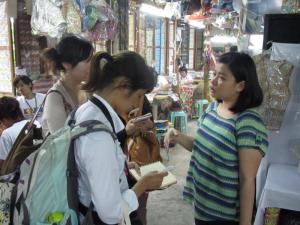
Interviews at NPO Kilus Foundation
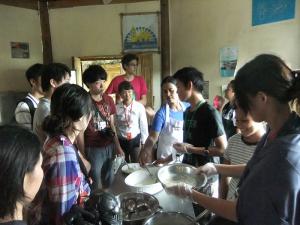
Making cheese at the Gawad Kalinga Enchanted Farm
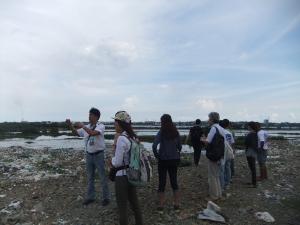
Waste disposal site being revitalized in Mandaue, the Province of Cebu
(2) The Province of Cebu
Following Metromanila, the group visited Mandaue City on Cebu Island. Cebu attracts a lot of tourists from Japan. Mandaue once had a bad reputation as the most polluted city but achieved dramatic environmental improvement because of its successful environmental policies. The city was even awarded in 2001 as the cleanest and greenest city. After meeting the mayor of Mandaue, the participants took a lecture on measures taken in the city against waste by Mr. Mendoza, manager of the municipal solid waste management. The city proceeds with a plan to properly dispose of organic waste, which accounts for 60 percent of its solid waste, thereby cutting its cost and using the saved portion of the budget for other beneficial projects. The city also introduces the Takakura Composting Method to each household and encourages them to use the compost for their flower beds or vegetable gardens.
The participants visited a site once called the Umapad sanitary landfill. The site has now been flattened. In the future, the city plans to use the landfill as a location to temporarily store resources recovered from barangays - villages, districts or wards. On both sides of the road to the landfill, there is an area where low-income earners called waste pickers live, salvaging valuable or recyclable materials at the site. Many of the participants were at a loss for words when they saw their living conditions with their own eyes.
Mandaue gives official commendations to barangays which have actively made efforts for waste disposal. The Japanese group visited two barangays in the city, which won the first or second prizes. These two barangays compost organic waste and sell the compost to local people such as farmers. Crushed plastic pieces are reused as cushion and pillow filling, covered by vinyl leather scrapped as waste at furniture factories. The participants not only saw cushions and pillows produced there but also conducted interview surveys with local residents along their own themes.
Four short-term participants wrapped up their tightly scheduled ten-day program and flew back to Japan by way of Manila.
(3) The Province of Palawan
The long-term participants went to Palawan Island, known as the last Eden, richly endowed with nature. Accompanied by an official from the Puerto Princesa municipal government, they visited the Subterranean River National Park, listed as a UNESCO World Heritage Site. They learned about the Community-Based Sustainable Tourism, which supports the idea of using tourism resources while conserving nature. The park restricts the number of visitors per day. Visitors are required to book the admission in advance and pay entrance fees and environmental taxes. Local residents work as rowers of boats to or in the cave and are well trained to entertain tourists as tour guides.
Then, the participants visited two NPOs actively engaging in activities to protect nature. One is an organization which conducts activities fraught with danger. Together with the police, the NPO cracks down on those who smuggle out of the country valuable ebony, illegally cut down, and on poachers who throw bottles of cyanide at coral reefs to knock out and catch fish. The other is an NPO group of lawyers and scientists that gives legal or scientific support to local residents in conferring with governments, while presenting proposals to them. The participants found the explanations by the two NPOs quite interesting because their unique activities differ largely from those of Japanese NPOs.
At presentation sessions in the Philippine cities they visited, the participants made presentations and proposals based on what they had surveyed and examined as groups. A session in Mandaue was attended by the city’s solid waste manager, representatives from the two barangays they visited, and local NPO staff. A group focusing on water contamination explained how polluted river water in the city is by using simplified water inspection products. Another group on waste management suggested that the city should introduce a system of environmental instructors, designed to visit every household and promote waste reduction. The municipal manager responded in a positive way, saying that the proposed idea will absolutely be taken into serious consideration. There was also a session in Puerto Princesa. City officials and representatives from the NPOs the participants visited listened with great interest to presentations by each group. These Filipinos also raised questions about insufficient parts of the presentations and proposals, which were results of only a short-period survey.
In Palawan, the participants visited the OISCA Agricultural Training Center, too. OISCA is widely known to local people in the province. According to the center, young people come here from neighboring towns or villages to obtain knowhow and skills in the agricultural field. It didn’t take long for the Japanese participants to become friendly with the young Filipinos. They planted papaya and rubber trees together. The participants also visited OISCA-supported Mabini Elementary School. Although it was a Saturday, they were welcomed by many students there. They made ‘origami’ with the pupils, showing them the art of folding paper into various figures, and performed their own short play of the importance of environmental protection. In return, the children performed dances for them. They all had a good time, and the visit ended by everybody planting mahogany trees together at the school. Then, the Japanese drove to a coastal area at low tide and planted 100 young mangrove trees. It appeared easy and simple to walk on the muddy beach, make a hole with a metal rod, and insert a young plant into the hole, but the work required more physical strength than expected. The participants learned how valuable grown mangrove forests are through their planting experiences because there is only a low possibility that young plants will take root on the muddy beach.
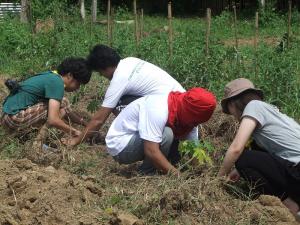
Commemorative tree planting at OISCA Training Center in Palawan
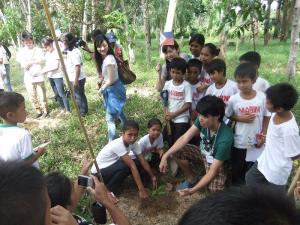
Performing a play about the environment at Mabini Elementary School in Arbolan, Palawan

Planting mangroves

Young mangrove trees
(4) Metro Manila (revisited)
After returning to Manila, the Japanese participants visited Laguna de Bay, the largest lake in the Philippines. The lake is about 1.3 times as large as Lake Biwa, the largest in Japan, and supplies water to agriculture and manufacturing industries while also accommodating fish farms. In Binangonan, there is a problem that water hyacinths growing profusely along the coastal areas block the way of fishing boats, and the participants saw a fisherman dive into the lake and help move a boat forward.
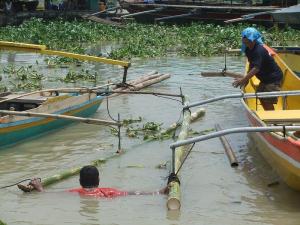
Fisherman helping move a boat in Laguna de Bay where water hyacinths grow profusely.
The participants took a lecture on the Participatory Local Social Development, PLSD, at the University of the Philippines. It was intended for them to learn about what to do to make projects take root in the area when the projects are implemented. After the lecture, they had an opportunity to meet and talk with Japanese and Philippine students at the university.
At the end of the long-term program in the Philippines, the participants visited the Embassy of Japan facing Manila Bay. With the use of images, they explained to Embassy officials their program activities and efforts in the country. They also listened to the secretaries about the current situation of the Philippines, including NGO or NPO activities and future demands.
Throughout their stay in the Philippines, only English was used. Therefore, there were some participants who had trouble correctly catching what people said or smoothly speaking English at the beginning of the program. Day by day, however, they came to ask more questions and more actively interview local residents, thus showing significant changes in their attitudes. They learned that serious poverty causes local people to engage in environmental destruction. The poverty level in certain places there was far beyond their imagination. Their visits to various sites and understanding from their experiences seem to have yielded them a good harvest. The participants also commented that it was quite a great opportunity for participants from different backgrounds to meet and learn from each other.
After returning home, the participants made reports based on what they obtained from interviews with local Filipinos, and made presentations of their reports at a debriefing session on November 15. This session marked the end of the busy four-month period that started with advance preparations in August. It is highly expected that they will make the best of their experiences in the Philippines to contribute to future NGO or NPO activities and international cooperation.







